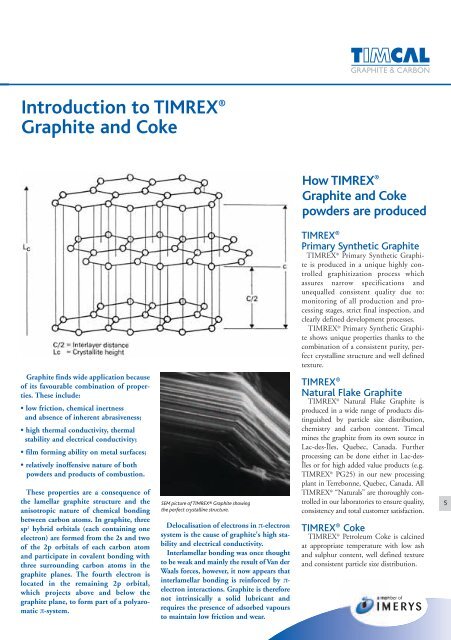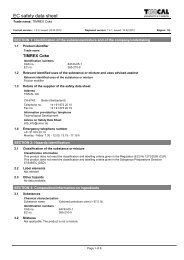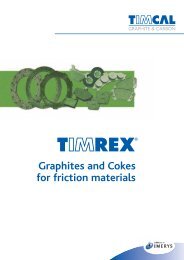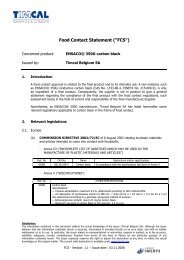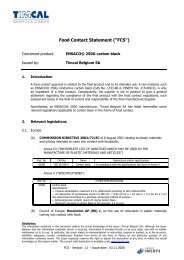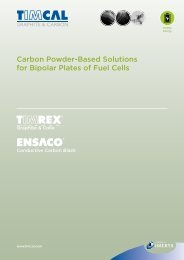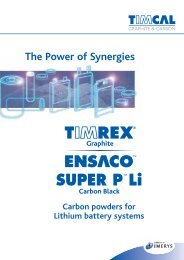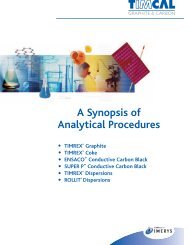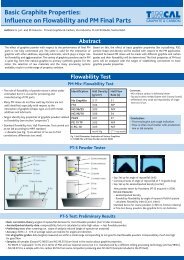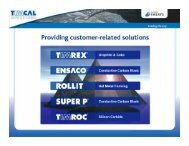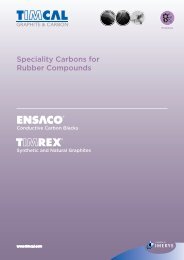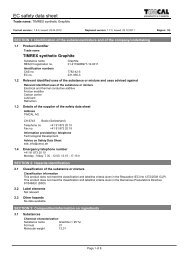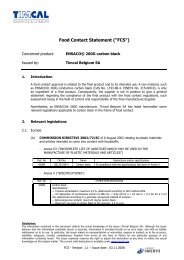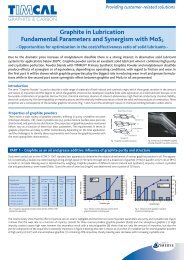ENSACO® Conductive Carbon Black for polymer ... - Timcal Graphite
ENSACO® Conductive Carbon Black for polymer ... - Timcal Graphite
ENSACO® Conductive Carbon Black for polymer ... - Timcal Graphite
Create successful ePaper yourself
Turn your PDF publications into a flip-book with our unique Google optimized e-Paper software.
Introduction to TIMREX ®<br />
<strong>Graphite</strong> and Coke<br />
N<strong>Graphite</strong> finds wide application because<br />
of its favourable combination of properties.<br />
These include:<br />
low friction, chemical inertness<br />
and absence of inherent abrasiveness;<br />
high thermal conductivity, thermal<br />
stability and electrical conductivity;<br />
film <strong>for</strong>ming ability on metal surfaces;<br />
relatively inoffensive nature of both<br />
Npowders and products of combustion.<br />
NThese properties are a consequence of<br />
the lamellar graphite structure and the<br />
anisotropic nature of chemical bonding<br />
between carbon atoms. In graphite, three<br />
sp 2 hybrid orbitals (each containing one<br />
electron) are <strong>for</strong>med from the 2s and two<br />
of the 2p orbitals of each carbon atom<br />
and participate in covalent bonding with<br />
three surrounding carbon atoms in the<br />
graphite planes. The fourth electron is<br />
located in the remaining 2p orbital,<br />
which projects above and below the<br />
graphite plane, to <strong>for</strong>m part of a polyaromatic<br />
π-system.<br />
SEM picture of TIMREX® <strong>Graphite</strong> showing<br />
the perfect crystalline structure.<br />
NDelocalisation of electrons in π-electron<br />
system is the cause of graphite's high stability<br />
and electrical conductivity.<br />
Interlamellar bonding was once thought<br />
to be weak and mainly the result of Van der<br />
Waals <strong>for</strong>ces, however, it now appears that<br />
interlamellar bonding is rein<strong>for</strong>ced by πelectron<br />
interactions. <strong>Graphite</strong> is there<strong>for</strong>e<br />
not intrinsically a solid lubricant and<br />
requires the presence of adsorbed vapours<br />
to maintain low friction and wear.<br />
How TIMREX ®<br />
<strong>Graphite</strong> and Coke<br />
powders are produced<br />
TIMREX ®<br />
Primary Synthetic <strong>Graphite</strong><br />
TIMREX ® Primary Synthetic <strong>Graphite</strong><br />
is produced in a unique highly controlled<br />
graphitization process which<br />
assures narrow specifications and<br />
unequalled consistent quality due to:<br />
monitoring of all production and processing<br />
stages, strict final inspection, and<br />
clearly defined development processes.<br />
TIMREX ® Primary Synthetic <strong>Graphite</strong><br />
shows unique properties thanks to the<br />
combination of a consistent purity, perfect<br />
crystalline structure and well defined<br />
texture.<br />
TIMREX ®<br />
Natural Flake <strong>Graphite</strong><br />
TIMREX ® Natural Flake <strong>Graphite</strong> is<br />
produced in a wide range of products distinguished<br />
by particle size distribution,<br />
chemistry and carbon content. <strong>Timcal</strong><br />
mines the graphite from its own source in<br />
Lac-des-Îles, Quebec, Canada. Further<br />
processing can be done either in Lac-des-<br />
Îles or <strong>for</strong> high added value products (e.g.<br />
TIMREX ® PG25) in our new processing<br />
plant in Terrebonne, Quebec, Canada. All<br />
TIMREX ® “Naturals” are thoroughly controlled<br />
in our laboratories to ensure quality,<br />
consistency and total customer satisfaction.<br />
TIMREX ® Coke<br />
TIMREX ® Petroleum Coke is calcined<br />
at appropriate temperature with low ash<br />
and sulphur content, well defined texture<br />
and consistent particle size distribution.<br />
5


